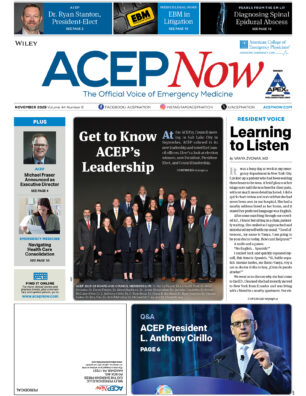This one goes out to the late, great Andy Rooney. I’m just old enough to remember Rooney for who he was in his final years on television: a curmudgeon who commandeered the last segment of “60 Minutes” every Sunday night, generally belly aching about something new in the world that he didn’t “get,” didn’t like, or both.
Explore This Issue
ACEP News: Vol 32 – No 07 – July 2013The basic thrust of each of his commentaries was, “I’m old, I’m set in my ways, and I’d like to talk to you about some new phenomenon that I have unilaterally decided is stupid.” And this was consistently great.
So, if it helps, please read the following in the voice of Andy Rooney.
Today, I’d like to talk to you about the rise of silly signs I keep seeing on the walls of our hospitals all over this fair country. The signs to which I refer are the friendly reminders to employees about ideal conduct, cheerful reminders of our duties, helpful safety tips, and the celebration of an awareness month of some sort (this month we are “celebrating” trauma awareness month, an entity I had not realized inspired or required celebration).
These signs are well-meaning and are supposedly harmless, if not even a little helpful, so the rationale goes. But are they? Take the following signs I saw recently. The first is about being friendly and professional and generally doing your job conscientiously. “O.N.E. Open – smile and say hello, say your name; Narrate (your care) – explain, review, share what you are doing; End – close, say goodbye, inform them of next step; ask, ‘Is there anything else I can do?’ ”
Here’s a sign about handing off patient care to another provider. “DRAW: Diagnosis and current condition of the patient; Recent changes in condition or treatment; Anticipated changes in treatment of conditions; What to watch out for in the next interval of care.”
This next one is mainly for nursing. “Monitoring 4Ps: Pain, Potty, Positioning, Personal Items.” I just have to chuckle at the word potty, glaring at me in 72-point font. I guess I’m not quite as mature as I thought.
Then there are more essential signs. For fires, there are two signs formatted onto one poster, one for fire safety and one for fire extinguishing. The first, for safety, reads: “RACE: Rescue; Alarm; Confine; Extinguish.” Of course when you get to that last line you had better keep reading the sequel sign for more information on fire extinguisher operation. “PASS: Pull; Aim; Squeeze; Sweep.” If your vision isn’t good enough, you might see only the large acronym letters on the sign and deduce that in the event of a fire you should “RACE PASS,” which I guess means get out of there as quickly as possible, because putting out a fire is not in your job description! You’ve got lives to save. Elsewhere.
Atul Gawande’s book, “The Checklist Manifesto,” describes in detail how doctors have applied checklists to medicine. Previously in the purview of engineers and pilots, data show that a well-written checklist, brief enough to be usable but comprehensive enough to address multiple sources of error and complications, can dramatically improve outcomes.
While many of us would like to believe we are above needing a checklist (we’re doctors, not chefs!), research over the past decade is impressive. When we insist on using well-designed checklists, our patients benefit. So what is the harm in a few annoying signs on the walls with cute memory aids? The answer is that when we are inundated by these lists, some of which state the obvious, we begin to resent them as signs that we are cogs in the wheel of the health care machine. It’s depersonalizing, a word we associate with burnout.
There’s nothing like a dose-response curve to demonstrate the effectiveness and eventual futility of an intervention. Indeed, there is an inflection point for every cure at which the medicine becomes worse than the illness. A study in the UK in 2008 showed that an increase in road signs (including safety signs) delayed reaction times of drivers. Others have reported that accident rates increased when more warning signs were added to certain stretches of dangerous road. It turns out that the more road signs there are, the less people think. Or, the more they are distracted by trying to make sense of the signs, by which time the time for appropriate action has come and gone.
Do you still remember what O.N.E. and D.R.A.W. stand for? Probably not. You remember the gist: Be friendly, be thorough, be professional, do your job well and with a good attitude. While I use mnemonics every day for patient care, and I must confess that checklists probably reduce infection rates when I’m placing central lines, the ubiquity of superfluous signs in our hospitals sends a conflicting message to our patients: We value patient care, but we need memory aids and constant reminders in order to do it. That’s a sign of something!
Dr. Faust is a second year Emergency Medicine resident at Mount Sinai Hospital and Elmhurst Hospital in New York City. He tweets at @jeremyfaust.
Pages: 1 2 | Multi-Page





No Responses to “The Signs Are All Around Us”